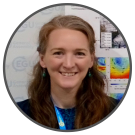Below are the biographies of all Poster and Podium Presenters for the 2021 MAC-MAQ Conference listed in alphabetical order.
Cedrick Ansorge
ERC Research Group Leader, University of Cologne, Institute of Geophysics and Meteorology
Cedrick Ansorge works on turbulence in the boundary layer, focusing on situations where the flow deviates from classical similarity theory due to strong stratification, heterogeneity, de-coupling from the surface or other processes. He uses turbulence-resolving modelling to advance the understanding in these regimes. Ansorge graduated from University of Hamburg and did his PhD at the Max-Planck-Institute for Meteorology in Hamburg and Hamburg University. Since 2015 he is affiliated with the University of Cologne. He was awarded a 2020 ERC Starting Grant to investigate the intermittency of turbulence.
Joaquim Arteta
CNRS
Libby Barnes
Colorado State University
Marc Calaf
Associate Professor, Department of Mechanical Engineering, University of Utah
Greg Carmichael
University of Iowa

Shu-Hua Chen
Associate Professor, Land, Air and Water Resources, University of California, Davis
Dr. Chen's research involves data assimilation, heavy orographic rainfall, and pollutant transport. Remote sensing data, such as SSM/I, QuikSCAT, MODIS, and radar are used to improve severe weather simulations and forecasts; The effects of the moist Froude number and the convective available potential energy on flow regimes associated with a conditionally unstable flow over a mesoscale mountain are investigated using idealized simulations; A tracer model based on a mesoscale model has been developed to study the source-receptor relationship and long-range transport. Dr. Chen teaches weather observation and analysis (ATM110) and severe and unusual weather (ATM10) at the undergraduate level, and numerical modeling of the atmosphere (ATM255) at the graduate level at UC Davis.

Stephanie Cleland
PhD Student, Department of Environmental Sciences & Engineering, Gillings School of Global Public Health, University of North Carolina at Chapel Hill
Stephanie is a PhD student at UNC-Chapel Hill in the Department of Environmental Sciences & Engineering. As an ORISE research participant at EPA’s Center for Public Health and Environmental Assessment, her current research focuses on the impacts of fires and smoke exposure on human populations and health. She develops exposure surfaces and uses environmental epidemiology and health impact assessments to describe the acute and chronic health effects of exposure to wildfire smoke.

Jerome Fast
Laboratory Fellow, Pacific Northwest National Laboratory
Dr. Fast obtained a Ph.D. in Meteorology from Iowa State University in 1990, has been a research scientist at Pacific Northwest National Laboratory since 1994, and became a National Center for Atmospheric Research (NCAR) affiliate scientist in the Atmospheric Chemistry Observations and Modeling (ACOM) laboratory in 2009. He is currently principal investigator of the Integrated Cloud, Land-surface, and Aerosol System Study (ICLASS) science focus area supported by the U.S. Department of Energy’s (DOE) Atmospheric System Research (ASR) program that consists of 28 scientists and 6 post-docs. ICLASS uses a “measurement-to-modeling” approach that links DOE user facility measurements with multi-scale modeling to develop an improved understanding of atmospheric processes and their interactions relevant to climate. His team continues to develop and implement modules describing meteorological and chemical processes for the Weather Research and Forecasting (WRF) community model, that is used by thousands of scientists around the world. Dr. Fast’s research interests and experience encompasses a wide range of atmospheric phenomena including: transport and dispersion processes, complex terrain circulations, boundary layer meteorology, mesoscale systems, trace gas and particulate chemistry, and aerosol-radiation-cloud interactions. He is an expert in developing, using, and interpreting atmospheric models to address key outstanding science questions associated with these atmospheric phenomena that are important for weather forecasting, air quality, and climate. While Dr. Fast is primarily a modeler, he has gained extensive experience in developing hypotheses to be tested with field campaign measurements, designing strategies to deploy instrumentation, and collecting/analyzing data. He has led and/or contributed to eight field campaigns since 1997, some of which had many participants from multiple agencies laboratories, and universities.
Johannes Flemming
Copernicus Atmosphere Monitoring Service, European Centre for Medium-Range Weather Forecasts

Marco Giometto
Assistant Professor, Columbia University, Department of Civil Engineering and Engineering Mechanics
Dr. Giometto received his BS and MS degrees in civil engineering from the University of Padua (2010), and a joint PhD in civil and environmental engineering from Braunschweig TU University and the University of Florence (2014). In 2016 he earned a second PhD in mechanical engineering from École Polytechnique Fédérale de Lausanne, where he won the EDME Award for the best thesis in mechanical engineering. Before joining Columbia University in 2018, he held postdoctoral positions at the University of British Columbia and at the Center for Turbulence Research, which is jointly operated by Stanford University and NASA Ames.
His research focuses on the fundamentals of turbulence, and its impact on the transport of mass, energy, and momentum in engineering and environmental systems. Insights from his research have implications in geophysics, engineering, biology, and energy technologies, where heat and mass transfer, evaporation, and skin friction often determine system performance or environmental impact. He uses high-fidelity computational techniques (such as direct and large-eddy simulation) along with analytical tools to gain insight into complex flow systems and to develop reduced-order models for use in interdisciplinary applications. Topics of interest include boundary-layer turbulence, turbulent transport in flows over and within complex surfaces (e.g. urban and vegetation canopies), and the response of turbulence to rapid distortions.

Lorenzo Giovannini
Assistant Professor, Atmospheric Physics Group, Department of Civil, Environmental and Mechanical Engineering, University of Trento
Lorenzo Giovannini is assistant professor at the Department of Civil, Environmental and Mechanical Engineering of the University of Trento (Italy). His research interests include the study of atmospheric boundary layer processes typical of mountainous regions and the evaluation of microclimatic alterations induced by urban areas, by means of both numerical modeling and experimental campaigns. He is involved in different research projects, focusing on the improvement of meteorological simulations over complex and urban terrain for different applications, such as pollutant dispersion, renewable energy and building energy consumption.

Tailong He
University of Toronto
Tailong He 5th year PhD student at University of Toronto. He has been working on applying data assimilation and machine learning methods on air quality and carbon cycle.

Daven Henze
University of Colorado
Dr. Daven Henze is a professor in the department of mechanical engineering at the University of Colorado Boulder. He holds a Ph.D. in chemical engineering from Caltech. Prior to joining the faculty at CU Boulder he was an Earth Institute Postdoctoral Fellow at Columbia University, where he worked at the NASA Goddard Institute for Space Studies. Dr. Henze’s research focuses on air quality, integrated environmental assessment tools, long-range pollution transport, and climate change. A large part of his research stems from chemical data assimilation, the process by which both models and observations are combined to produce estimates of the atmospheric state that are often more complete than those provided by either approach alone. This encompasses more specific interests in remote sensing, adjoint sensitivity analysis, inverse problems, source apportionment, and quantifying air pollution health impacts. Dr. Henze has received an EPA Early Career award, a NASA New Investigator award, and several university awards for teaching and research. He is the lead scientist for the GEOS-Chem adjoint model, a member of the GEOS-Chem Steering Committee, co-chair of the Hemispheric Transport of Atmospheric Pollutants (HTAP) Working Group on Source/Receptor relationships, a member of an EPA Clean Air Scientific Advisory Committee (CASAC), the NASA Earth Science Advisory Committee, and multiple NASA satellite science teams.

Emma Knowland
Research Scientist, Universities Space Research Association (USRA), NASA Global Modeling and Assimilation Office (GMAO)
Dr. Knowland is a lead scientist in the development of NASA GMAO’s atmospheric composition forecast system, GEOS-CF. She directs the transition from research & development to the production system and leads the evaluation of stratospheric composition in the GEOS-CF. Dr. Knowland’s research interests include both chemical and dynamical drivers of stratospheric and tropospheric composition. She is a member of the World Meteorological Organization (WMO) Global Air Quality Forecast and Information System (GAFIS) Steering Committee.

Yang Liu
Emory
Dr. Liu’s research interests include satellite aerosol retrieval and product design, the application of satellite data in public health research, the potential impacts of global climate change on public health, GIS and spatial statistics. Over the past 13 years, He has led multiple projects funded by NASA, CDC, NIH, EPA, HEI, and WHO to apply satellite data in air quality modeling and study the impact of climate change on air quality and human health using remote sensing and model simulations, and health impact of climate change related to extreme heat, wildfires, and ambient air pollution. He was an ORISE faculty fellow at the National Center for Environmental Health at the US CDC and a Co-investigator of USEPA's Southeastern Center for Air Pollution and Epidemiology. He is a science team member of the NASA EVI-3 MAIA and Terra MISR missions, and a PI member of the NASA Air Quality Applied Science Team (AQAST) and Health and Air Quality Applied Science Team (HAQAST).
Jeff McQueen
Air Quality and Dispersion Modeling Team Leader, National Center for Weather and Climate Prediction

David Peterson
Meteorologist, U.S. Naval Research Laboratory
Jilian Quimbayo-Duarte
Institut für Atmosphäre und Umwelt, Goethe-Universität Frankfurt
Juan Wang
Washington University in S.L.

Yang Zhang
Professor, Northeastern University
Dr. Zhang specializes in atmospheric and environmental research at the interface of Earth system sciences that crosses traditional disciplinary boundaries including energy, air, water, land, ocean, and human health. Over the years, Dr. Zhang has contributed to the development, improvement, application, and evaluation of major 3-D air quality, climate, and Earth system models on urban, regional, and global scales such as STEM III, GChM, MIRAGE, SCICHEM, CMAQ, CMAQ-MADRID, CAMx, MM5, WRF, and mesoscale and global-through-urban WRF/Chem, WRF/Chem-MADRID, WRF-CAM5, WRF/Chem-ROMS, and CESM/CAM5. Her group has also worked on Street-in-Grid models such as SinG, hydrological models such as WaSSI, and health modeling tools such as BenMAP-CE.
Dr. Zhang has devoted sustained efforts to solve some of the most pressing and challenging environment- and energy-related scientific and technical issues related to air and water pollution, acid deposition, global warming and other adverse climate change, as well as associated adverse human health and ecosystem impacts. Dr. Zhang’s research advances the scientific understanding of major atmospheric and environmental issues by developing and utilizing numerical models and analysis tools at various scales (from local to global) to address relevant science and policy questions pertaining to controlling air pollution, mitigating adverse climate change and human health, and minimizing environmental damages in the entire Earth system.
